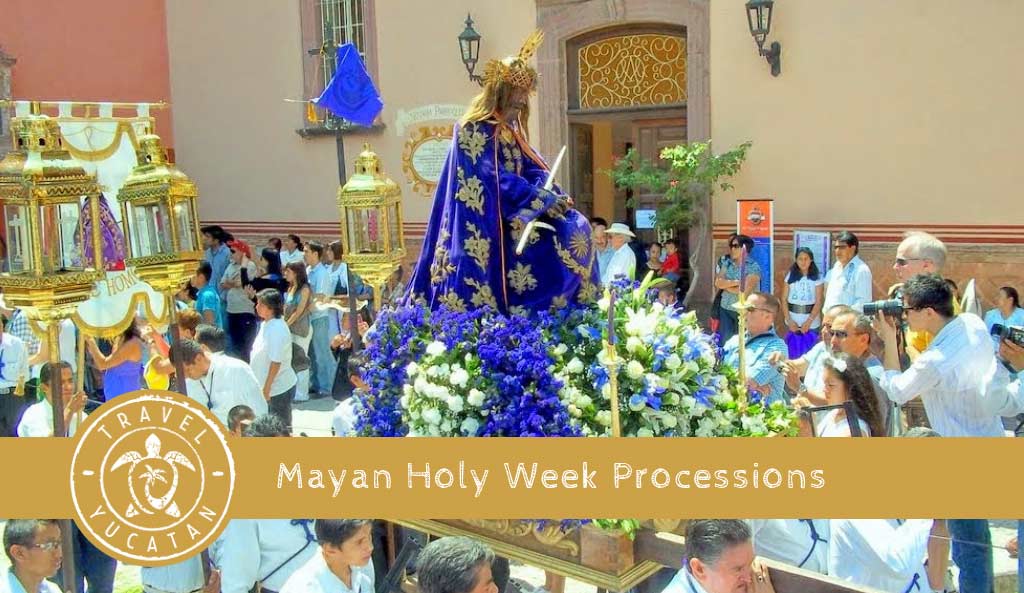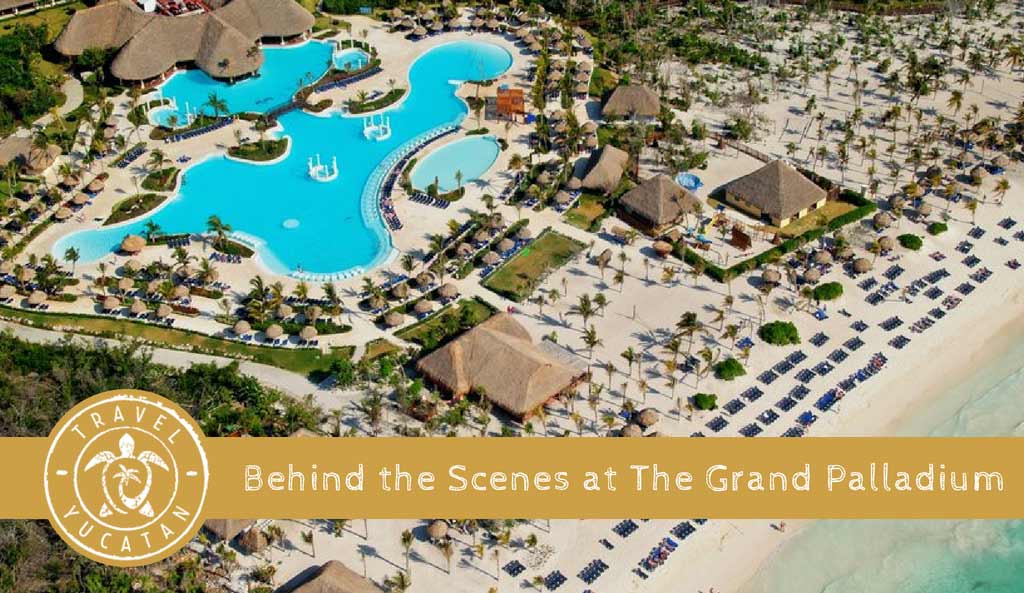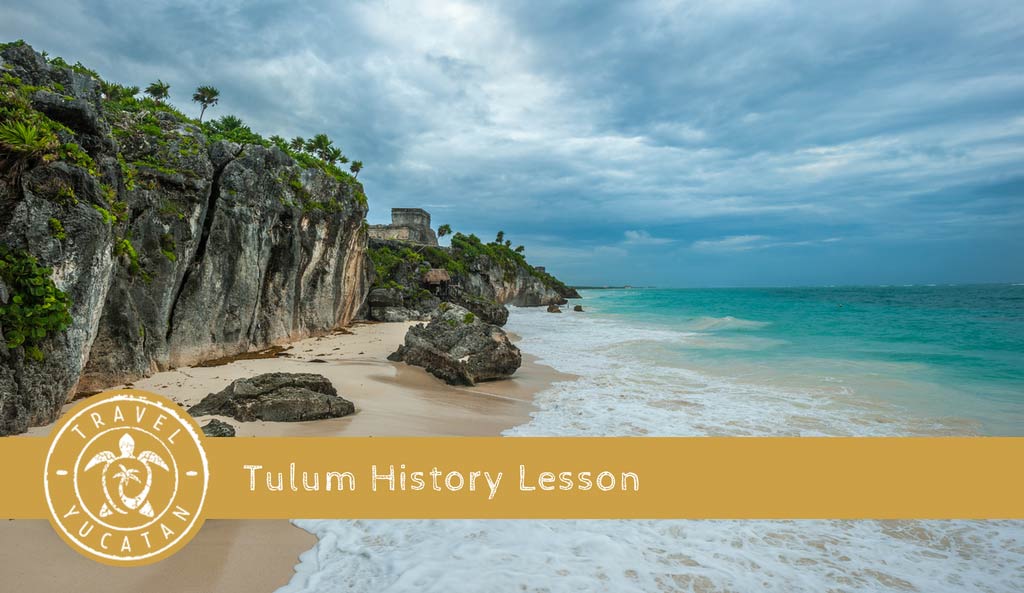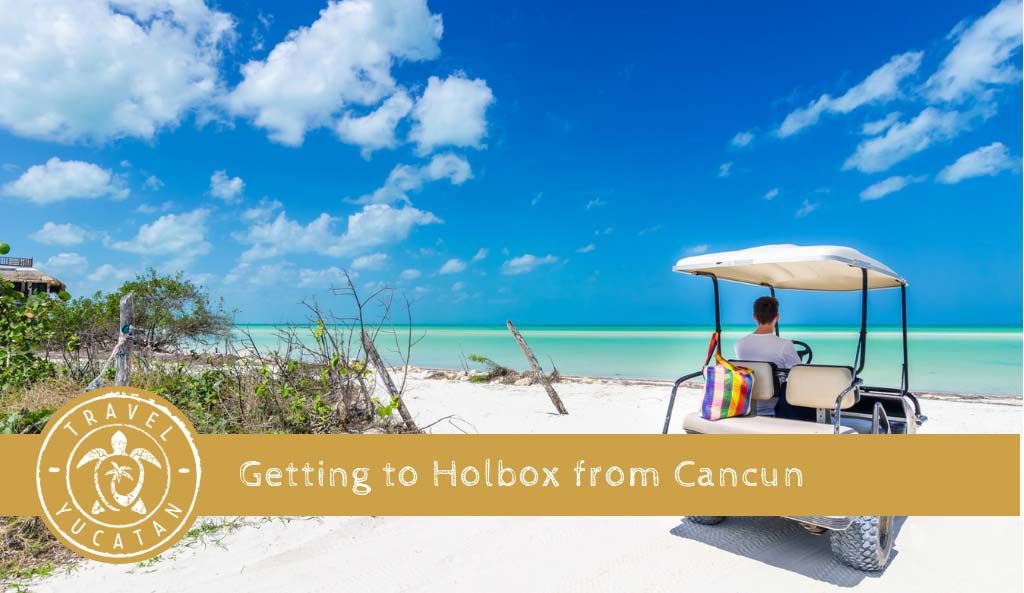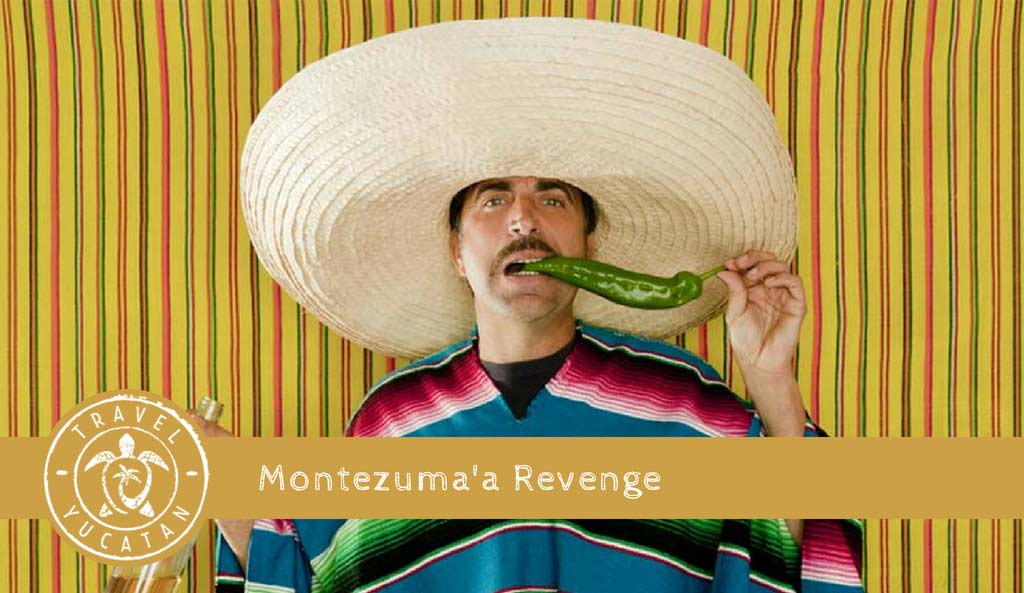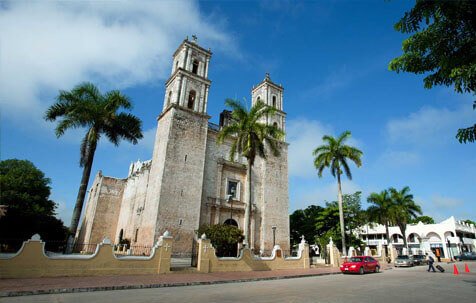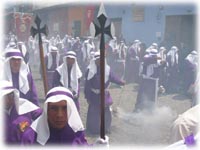 Processions are religious parades that march for hours on end around towns and cities during Semana Santa – Holy Week.
Processions are religious parades that march for hours on end around towns and cities during Semana Santa – Holy Week.
The first religious procession in Guatemala happened in 1543 and was modeled after the processions that took place in Spain. Antigua, Guatemala is home to the world’s largest Holy Week celebration. Processions take place on Fridays and every Sunday in Lent and throughout Holy Week, culminating in the resurrection procession on Easter Sunday.
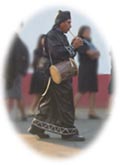 A procession generally consists of a traditional Mayan flutist leading the processions, then the flag and banner carriers, the incense burners, then the float [anda] and finally the marching band [banda de musica]. A clean-up crew follows the procession cleaning up the carpets.
A procession generally consists of a traditional Mayan flutist leading the processions, then the flag and banner carriers, the incense burners, then the float [anda] and finally the marching band [banda de musica]. A clean-up crew follows the procession cleaning up the carpets.
The religious processions are organized and carried out by the brotherhoods [los hermandades]. The brotherhoods were originally called cofradias and are religious organizations. The brotherhoods are either men or women, never both. It is thought that the marchers [cucuruchos or penitente] participated solely as a form of penance.
Today there is some degree of social status involved but the principal motivation is still a show of devotion by the cucuruchos.
Every procession departs from its church and follows a predetermined route before returning to the church several hours later. Purple is the color of the robes worn by the carriers up to Good Friday. Purple flags are also flown on masts. The robes and flags are switched to black on Saturday to signify mourning. On palm Sunday traditional Mayan costumes are worn for the procession.
Processions are distributed over 5 days:
Palm Sunday: The day when Jesus arrived in Jerusalem.
Holy Thursday: The day when Jesus gave Last Supper, followed by the beginning of his passion.
Good Friday: Jesus’ crucifixion, performed in 14 stations.
Holy Saturday: Loneliness of the Blessed Virgin Mary.
Easter Sunday: The resurrection of the Christ.
NOTE: Processions actually start during Lent, which begins Ash Wednesday, however the major proceesions occour during Holy Week.
Processions begin in the prospective church that houses the anda. Velaciones are holy vigils that take place inside churches, where scenes depicting events leading to Christ’s death and resurrection are depicted on altars. Beautiful carpet offerings [Alfombras], complete with fresh fruits and flowers are built, usually in front of the alter or anda. Many villages do not have a parish priest, which is why you may see line-ups of people. In order to fulfill their Easter duty of confessing and taking communion on Easter Sunday, the parishioners wait in line in church as a visiting priest hears their confession.
Before a procession begins, a ceremony and other rituals are performed inside the church by the cucuruchos. The band waits outside; sometimes they play or a person, male or female shouts evangelical style speeches into a microphone.
The cucuruchos exit the church in the order they march [horses and chariots do not start from inside a church but wait outside].
In some cities palm arches are erected and anyone entering the area of the church must pass underneath an arch.
The incense burners carry large burners [incensario] that create a large amount of smoke and fire. At night they burst into flame and make a very dramatic spectacle. The incense burnt is traditional copal incense used by the Maya as long as anybody remembers. This incense is said to purify the air of evil energies. Sometimes the smoke is so thick you cannot see the other side of the street. Often you will see cucuruchos gagging or covering their faces with handkerchiefs to breathe.
Copal is strong incense and can give a person a light-headed effect. After a couple of days of processions you smell copal everywhere you go, hours after a procession has gone by.
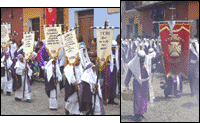 The cucuruchos also carry banners and flags with various Catholic religious symbolisms as well as codes to signify their duty to carry an anda.
The cucuruchos also carry banners and flags with various Catholic religious symbolisms as well as codes to signify their duty to carry an anda.
It must be noted here that not every city/village celebrates Holy Week [Semana Santa] the same although it may look like the same thing the variations lie in how “converted” the inhabitants are. In some areas there is a higher degree of traditional Mayan influence. If you know what to look for the influences are obvious.
THE PROCESSION MARCH
Although there are processions during the week the big ones start on Good Friday. In Antigua the Good Friday procession starts around 9:00 a.m. They move slowly, very slowly.
Each procession has a Capataz who is the person who directs the cucuruchos carrying the floats [anda]. The marchers use a system of touching the person in front of them when the procession is to come to a halt. This happens frequently. The floats weigh tons, literally. The costaleros must be changed frequently to ensure nobody gets too tired and causes a break-down or worse, an anda dropping.
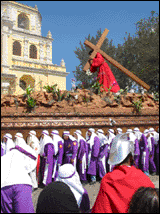 Unbelievably there are also cucuruchos underneath the anda, quite often children. These carriers are called Costaleros. Although I was unable to find out why they do this, it appears that it is a sign of “faith” that the heavy anda will not come crashing down on some unsuspecting victims, crushing them to death.
Unbelievably there are also cucuruchos underneath the anda, quite often children. These carriers are called Costaleros. Although I was unable to find out why they do this, it appears that it is a sign of “faith” that the heavy anda will not come crashing down on some unsuspecting victims, crushing them to death.
Cucuruchos march along side the andas carrying short poles that they use to hold an anda up while the cucuruchos take a rest or change. Generally a group carries an anda for around half an hour before switching. When switching they attempt to find carriers who are all the same height so there are no low-points throwing off the equilibrium.
Some andas are on carts with wheels and are pulled by the cucuruchos. Most if not all andas are equipped with lights. Behind the anda will be a smaller cart carrying the gas-powered generator.
Just before an anda are special pole carriers that lift up overhead power lines so the andas don’t crash into them. Other cucuruchos carry back-packs that are filled with copal to replenish the incense burners when needed.
Interestingly large processions in towns with a large hermandades [brotherhood] will be made up of 100% of the hermandades while processions in places more traditionally Mayan with a smaller hermandades will actually enlist persons from the crowd to help carry an anda, even gringos.
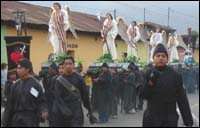 Each procession has a different tunica [robe] worn by the cucuruchos. The tunica can be rented or purchased from stores in town. They can also be made by hand if one possesses the ability.
Each procession has a different tunica [robe] worn by the cucuruchos. The tunica can be rented or purchased from stores in town. They can also be made by hand if one possesses the ability.
The Good Friday procession is a male affair. Thousands of purple robed cucuruchos parade down the street. There are chariots, Roman soldiers on horseback, Roman foot soldiers carrying spears and banners. Numerous incense burners fill the air with copal and the sheer determination and pain witnessed by the anda carriers is astonishing. Because the processions move so slowly you can easily run around to different vantage points and watch sections of a procession as many times as you wish. Although it gets quite crowded on Friday there is still room to navigate the city’s narrow sidewalks.
Early on Good Friday morning, preparations begin for a mock trial and sentencing of Christ. Participants dress as Roman soldiers, Pontius Pilate and other participants in the drama. Men of the Brotherhood act out the story of Barabbas at the front of the procession.
A traditional custom on Good Friday during or prior to the processions is the act of releasing three prisoners from jail, selected for an act of penitence, then freedom. The prisoners then march with the procession shouldering heavy crosses. This was not observed in the Antigua Friday procession but may be observed in Guatemala City.
Friday night’s procession is quite amazing. It is a long procession of andas depicting scenes from the last days of Jesus. Anda after anda passes by with elaborately carved depictions lit by lights and covered in flowers. After a few roll by, you begin to wonder how many of these there are. It is a solemn procession and the darkness adds an element of brevity that one has to experience to fully comprehend. It is quite touching.
Each anda in this procession is pulled by black robed cucuruchos. The flames produced by the incense burners are dramatic and the carriers know the fire gets a crowd going and they work it. With the fire and smoke and lavishly carved religious figure, it is a sight to see. This procession marches all night long.
Saturday’s procession is the Virgin Mary’s procession, which hosts a mirage of black dressed women and men in their black robes. Hundreds of women dressed in black slowly march the route. The women carry the anda for this procession.
As usual a Mayan flute player leads followed by the banners and incense carriers. After the Virgin Marry anda come a number of smaller saint andas, also carried by women, followed by the band, then the street cleaners.
Flags and colors change from purple to black on Saturday.
The Virgin Marry procession goes all day long starting sometime around 3:00 PM. It is best viewed at night. At night many of the carpets are lit up with candles. Many people walk the streets holding candles and although not an official proclamation it is advised to turn off all house lights or remove any lights other than candles from the route.
Walking the streets past midnight is an enchanting experience. The combination of old-world charm, cobblestone streets, candles, carpets and incense is quite powerful, and then the procession comes by.
Silence is observed at night during the procession. Any loud talking or boisterous behavior will be met by “shoooshes” as the crowd reacts.
The evening procession is not as large as the afternoons. It is the same procession, however many of the women have gone home.
Sunday’s procession in Antigua is the “Procession of Resurrection”, which emanates from the San Pedro church. Sunday’s procession is not as elaborate or as crowded as the preceding day’s processions. In Guatemala City seven processions are held on Sunday emanating from seven different churches and are much larger due to the larger population.
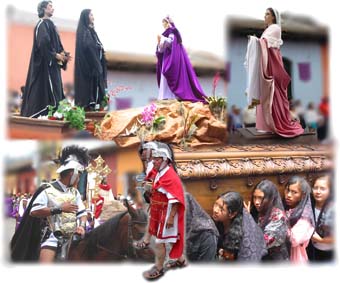 Probably the most unique aspect of the whole event to outsiders is the destruction of the carpets by processions. In fact many of the cucuruchos do their best to not walk over the carpets, sparing them even the slightest ruffle. Some cucuruchos are even successful in walking around a carpet with the anda they are carrying. However there is no escaping the big ones, they walk directly over the carpets destroying them in the process. If that doesn’t do it then the crowd that generally follows behind the procession does. Regardless the street cleaners sweep everything up right after.
Probably the most unique aspect of the whole event to outsiders is the destruction of the carpets by processions. In fact many of the cucuruchos do their best to not walk over the carpets, sparing them even the slightest ruffle. Some cucuruchos are even successful in walking around a carpet with the anda they are carrying. However there is no escaping the big ones, they walk directly over the carpets destroying them in the process. If that doesn’t do it then the crowd that generally follows behind the procession does. Regardless the street cleaners sweep everything up right after.
Cars left on a street by unknowing tourists are towed prior to a procession’s arrival. Signs [Via Procesional] are posted along procession routes warning drivers not to park there. Many do and the police give them a wide birth but as soon as they see the procession coming the tow-trucks move into action and within minutes a street is cleared.
Navigating a town or city during Holy Week can be a challenge as traffic is quite often rerouted to detour traffic from certain areas because of festivities or processions. Because of the many one-way streets quite common in Guatemalan cities this can become a challenge if you do not know the city well.
